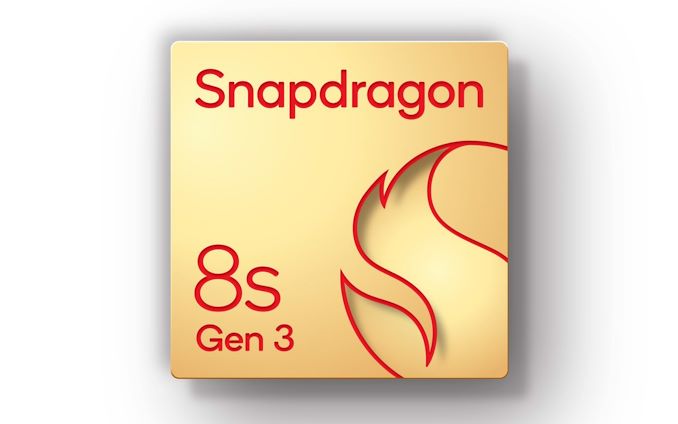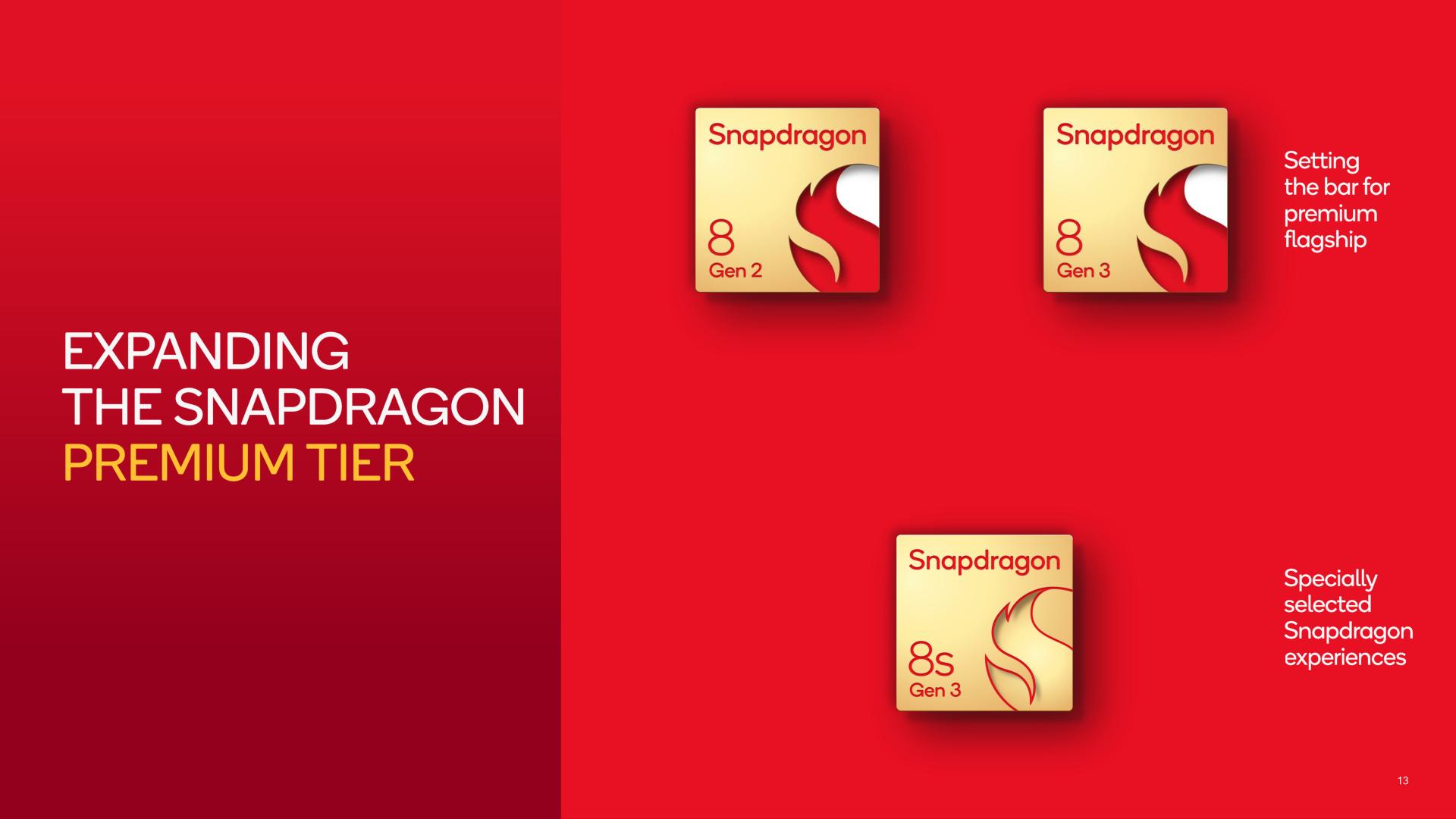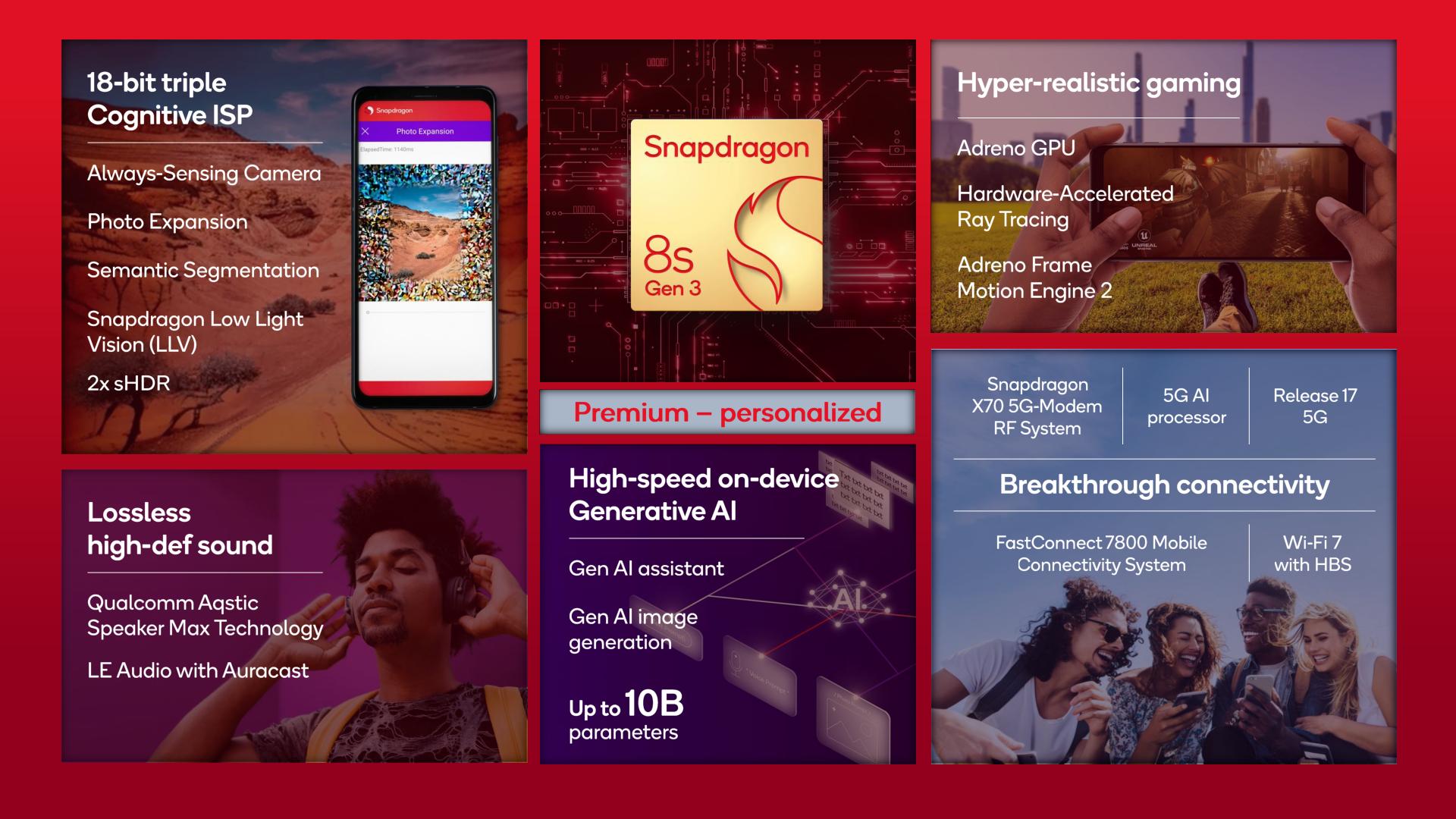Qualcomm Announces Snapdragon 8s Gen 3: A Cheaper Chip For Premium Phones
by Ryan Smith on March 18, 2024 2:30 AM EST- Posted in
- Mobile
- Snapdragon
- Qualcomm
- SoCs
- Cortex-X4
- Snapdragon 8s

With the launch of their flagship Snapdragon 8 SoC firmly behind them now, Qualcomm this morning is turning their collective head towards the premium market with the launch of another new Snapdragon 8 family SoC, the Snapdragon 8s Gen 3. The first of Qualcomm’s ‘s’-subseries of down-market parts to be released under the Snapdragon 8 banner, the Snapdragon 8s Gen 3 (8sG3) is intended to be a bridge part between the last-gen flagship 8 Gen 2 and current-gen flagship 8 Gen 3, offering a not-quite-flagship experience at a lower price point than Qualcomm’s top SoC. The new SoC is set to be available globally, with the first phones announced this month, though as is often the case for Qualcomm’s “premium” market SoCs, it looks like only Chinese handset OEMs will be picking up the chip, at least initially.
Although Qualcomm prefers to draw comparisons to their current gen flagship Snapdragon 8 Gen 3, the Snapdragon 8s Gen 3 is by and large and enhanced version of the Snapdragon 8 Gen 2. Many of the hardware blocks of the 8G2 have been carried over to the new chip – either in whole or in terms of functionality – a process that is made very easy thanks to the fact that Qualcomm is building the chip on the same TSMC 4nm node as the 8G2 and 8G3. Compared to the 8G2 then, there are two key differentiators for the 8sG3: a newer CPU complex lifted from the 8G3, and official on-device generative AI support.
| Qualcomm Snapdragon 8 SoCs | ||||
| SoC | Snapdragon 8 Gen 3 (SM8650) |
Snapdragon 8s Gen 3 (SM8635) |
Snapdragon 8 Gen 2 (SM8550) |
|
| CPU | 1x Cortex-X4 @ 3.3GHz 3x Cortex-A720 @ 3.2GHz 2x Cortex-A720 @ 3.0GHz 2x Cortex-A520 @ 2.3GHz 12MB sL3 |
1x Cortex-X4 @ 3.0GHz 4x Cortex-A720 @ 2.8GHz 3x Cortex-A520 @ 2.0GHz |
1x Cortex-X3 @ 3.2GHz 2x Cortex-A715 @ 2.8GHz 2x Cortex-A710 @ 2.8GHz 4x Cortex-A510 @ 2.0GHz 8MB sL3 |
|
| GPU | Adreno (Hardware RT & Global Illum.) |
Adreno (Hardware RT) |
Adreno (Hardware RT) |
|
| DSP / NPU | Hexagon | Hexagon | Hexagon | |
| Memory Controller |
4x 16-bit CH @ 4800MHz LPDDR5X / 76.8GB/s |
4x 16-bit CH @ 4200MHz LPDDR5X / 67.2GB/s |
4x 16-bit CH @ 4200MHz LPDDR5X / 67.2GB/s |
|
| ISP/Camera | Triple 18-bit Spectra ISP 1x 200MP or 108MP with ZSL or 64+36MP with ZSL or 3x 36MP with ZSL 8K HDR video & 64MP burst capture |
Triple 18-bit Spectra ISP 1x 200MP or 108MP with ZSL or 64+36MP with ZSL or 3x 36MP with ZSL 4K HDR video & 64MP burst capture |
Triple 18-bit Spectra ISP 1x 200MP or 108MP with ZSL or 64+36MP with ZSL or 3x 36MP with ZSL 8K HDR video & 64MP burst capture |
|
| Encode/ Decode |
8K30 / 4K120 10-bit H.265 H.265, VP9, AV1 Decoding Dolby Vision, HDR10+, HDR10, HLG 720p960 SlowMo |
4K60 10-bit H.265 H.265, VP9, AV1 Decoding Dolby Vision, HDR10+, HDR10, HLG 1080p240 SlowMo |
8K30 / 4K120 10-bit H.265 H.265, VP9, AV1 Decoding Dolby Vision, HDR10+, HDR10, HLG 720p960 SlowMo |
|
| Integrated Radio |
FastConnect 7800 Wi-FI 7 + BT 5.4 2x2 MIMO |
FastConnect 7800 Wi-FI 7 + BT 5.4 2x2 MIMO |
FastConnect 7800 Wi-FI 7 + BT 5.3 2x2 MIMO |
|
| Integrated Modem | X75 integrated 3GPP Rel 18 (5G NR Sub-6 + mmWave) DL = 10000 Mbps UL = 3500 Mbps |
X70 integrated 3GPP Rel 17 (5G NR Sub-6 + mmWave) DL = 5000 Mbps UL = 3500 Mbps |
X70 integrated 3GPP Rel 17 (5G NR Sub-6 + mmWave) DL = 10000 Mbps UL = 3500 Mbps |
|
| Mfc. Process | TSMC 4nm | TSMC 4nm | TSMC 4nm | |
Starting with the CPU complex, Qualcomm is implementing Arm’s latest generation of Armv9 CPU cores here, meaning a mix of the Cortex-X4, Cortex-A720, and Cortex-A520. Relative to the flagship 8G3, the 8sG3 gives up one of its performance cores for another efficiency core, shifting the design from a 1/5/2 configuration to a 1/4/3 configuration – the same as the 8G2. The 8sG3 also loses some frequency headroom in the process, with the X4 prime core dropping from 3.3GHz to 3.0GHz, and the other CPU cores following similarly along.
Still, the 8sG3 should outperform the 8G2 in CPU tasks, which is the primary reason for replacing the CPU complex at all. Qualcomm is basically looking to offer an 8G2 with better CPU performance and energy efficiency, and using Arm’s latest CPU cores will be how they deliver on that.
Outside of the CPU complex, however, most of the rest of the functional blocks are either lifted from the 8G2, or are the same generation teams of features. This means the 8sG3’s integrated GPU offers hardware raytracing, for example, but not the global illumination support that was introduced for the flagship 8G3. The memory controller is also otherwise identical to the 8G2, with the SoC supporting a maximum of 24GB of LPDDDRX-8400.
The video recording and decoding capabilities of the 8sG3 are a distinct downgrade from the other Snapdragon 8 SoCs, however. Qualcomm has retained their trio of 18-bit Spectra ISPs – so the SoC can support up to 3 cameras – but all 8K support has been excised entirely. Instead, the 8sG3 can only record video at up to 4K, and even then only at 60fps, half the framerate of the 8G3/8G2. Slow-mo video capture has also been altered, as well; Qualcomm lists 1080p240 for this mode rather than 720p960. The higher resolution will no doubt be appreciated, but less so if this means it’s not possible to record above 240fps.
The lack of 8K video support also applies to the SoC’s video decode block, which can only decode videos up to 4K in resolution. Qualcomm has otherwise kept all of the underlying features of the video decode block at parity, however, so the 8sG3 gets support for AV1 decoding, along with Dolby Vision HDR.
Meanwhile, the DSP/NPU situation on the 8sG3 is a mixed bag. Officially, this SoC supports generative AI models (up to 10B parameters in size), something the 8G2 and its NPU were not capable of, and is otherwise only available on the 8G3. However, according to Qualcomm this is not the same generation of NPU IP as on the 8G3, and among other things it lacks support for speculative decoding (and I don’t see any mention of the newer NPU’s micro-tile inferencing improvements). So by all appearances, this is just the 8G2 NPU. Still, Qualcomm has at least rolled out some software/firmware updates to improve its functionality, giving it additional AI functionality right as exuberance for that is through the roof.
Finally, the comms side of the 8sG3 is essentially a slower version of the 8G2. Qualcomm is once again using their Snapdragon X70 integrated modem here, a 5G Release 17-generation design that offers 2x2 MIMO on mmWave, and 4x4 MIMO on sub-6G. Max upload speeds are unchanged, at 3.5Gbps, however max download speeds for the 8sG3 are 5Gbps, half that of the 8G2 (and 8G3). Paired with the X70 modem is Qualcomm’s FastConnect 7800 system, which offers Wi-Fi 7 support with 2x2 MIMO, as well as Bluetooth 5.4. The dual BT antenna feature from the other Snapdragon 8 chips has also made it over for this part.
Overall, the Snapdragon 8s Gen 3 is intended to occupy a very specific niche within Qualcomm’s SoC lineup, offering a cheaper alternative to their flagship SoC without giving up too many features. The marketing messaging behind the chip is made somewhat complicated by the fact that last year at this time Qualcomm launched the Snapdragon 7+ Gen 2 for the premium market, which at least partially overlaps what they’re trying to do with the 8sG3. None the less, Qualcomm insists there’s a market for chips between the Snapdragon 7 series and the flagship Snapdragon 8 SoC, and so here we are.
Absent another 7+ chip this year, it’s hard to see the 8sG3 as anything other than the 7+’s successor. Still, where the 7+ was a souped-up 7, the 8sG3 is clearly a down-market 8, so it has some significant hardware advantages, particularly when it comes to memory bandwidth. It may just be that Qualcomm aimed a bit too low for the premium market with the specs for the 7+, so this is an attempt to aim a bit higher.
In any case, expect to see the Snapdragon 8s Gen 3 picked up by many of the usual Chinese handset OEMs, including Honor, iQOO, realme, Redmi and Xiaomi. The first phones are expected to be announced this month.
Source: Qualcomm


















8 Comments
View All Comments
GeoffreyA - Monday, March 18, 2024 - link
Thanks for the detailed article. As always, it's good to see AV1 decoding. What I'd like to see next is VVC decoding taking a foothold. Recently, FFmpeg implemented a VVC decoder in its avcodec library, and after intra-block coding got added, it works all right, but is slow. Most software players will soon get VVC playback automatically because they use the avcodec library. And once VVenC is properly added to FFmpeg, encoding in this codec should gain traction. I predict, however, that it won't dethrone AV1 any time soon, let alone H.264.Dante Verizon - Monday, March 18, 2024 - link
It should be illegal not to disclose the detailed specs of a product, "Adreno GPU" but what a vague and generic thing to write...Threska - Monday, March 18, 2024 - link
Sign an NDA. Remember whom we're talking about here.PeachNCream - Monday, March 18, 2024 - link
Read a review at a website that still runs phone benchmarks and decide of a phone containing said chip is worth buying. Knowing more or less about the GPU won't change that situation either way so the details are pretty unimportant.StormyParis - Monday, March 18, 2024 - link
I'm waiting for the Snapdragon 8.75sfe Gen 3.333333.A mere 8s Gen3 can't possibly be enough for me.
Let me get my branding crystal ball out... Next move: More "X" in the name ! "X" means "even better" ! I give it... 3 yrs. Get ready for the SD 8x Gen 6, pronounced "sdayxdjènsx".
StormyParis - Monday, March 18, 2024 - link
" The 8SG2 also loses some frequency"What's that 8SG2 thou speaketh about ? Those names are so clear and not unwieldy at all, how, HOW ??? could you, a professional, get confused, when it's so clear for the rest of u... never mind.
GeoffreyA - Monday, March 18, 2024 - link
Methinks, the computer confuseth mine own brain.ceisserer - Monday, March 18, 2024 - link
"the Snapdragon 8s Gen 3 is by and large and enhanced version of the Snapdragon 8 Gen 2."I wonder whether the author has even once looked at the spec-table he copied into the article himself...